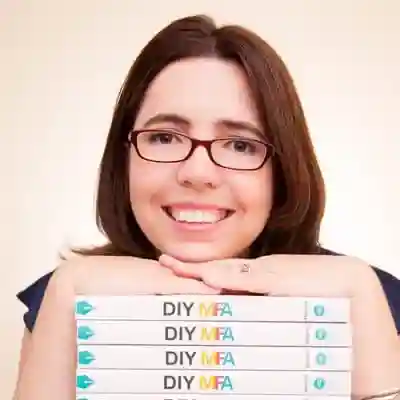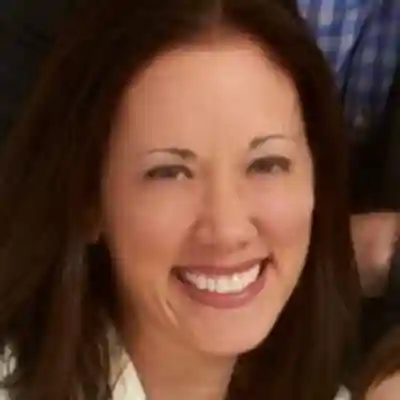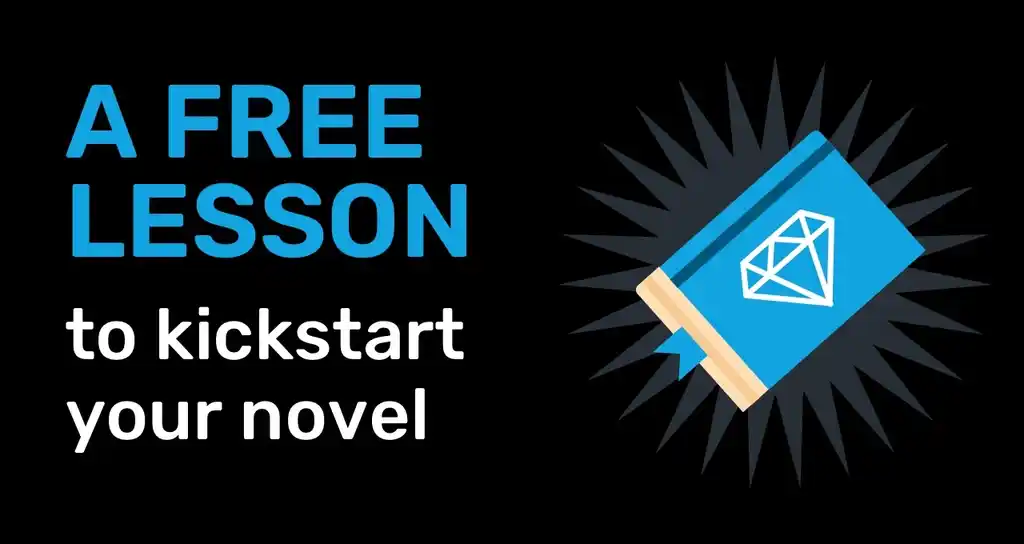This transcript has been edited for clarity. To ask about her ghostwriting services, contact Michelle through her Reedsy profile, and don’t forget to subscribe to her YouTube channel.
A bit about me
So I used to be a public school teacher. That was my first job right out of college. Then I was a travel and food writer, living abroad for a few years. And then — long, ridiculous story short — I ended up actually getting tuberculosis and pneumonia, and I had to quarantine myself. That was when I started writing books.
I was confined to my bed and all I could do was sit on my laptop and write, so I started really working on my first novel. A few years later, I got a literary agent. My first series came out in 2014 and since then I've published 13 novels under my own name. I've got a couple more under contract. One's coming out in a few weeks, another one in December. So yeah, a career was born from illness.
Today I want to cover three broad topics:
- The difference between Middle Grade and YA
- Content in Middle Grade (what you “can and can't” write)
- Marketing, especially marketing Middle Grade novels in a post lockdown world.
Middle Grade vs Young Adult
In 2015, I finished a draft of a Middle Grade novel and I was super excited about it. And I sent it to a critique partner of mine — one who had been an agent for 10 years. She was super knowledgeable about Middle Grade and Young Adult and I was so excited to get feedback from her.
She took a few days to read it and then she was like, "Can we just meet up for coffee and talk about this instead of me giving you notes?"
So we meet up and she starts talking about how much she loved the premise, she loved the world, she loved the characters. She was saying all this nice stuff. And I started to think, "Okay, the axe is about to fall."
Sure enough, she finally pauses and takes a deep breath and she says, "Okay, can I be honest? This book is not Middle Grade. This book is Young Adult." And I should mention that at this point I had published two Middle Grade series already. So this was not a new territory for me. I thought I knew the difference.
My instinctive response was, "But my characters are 12." But even as I said that, I knew she wasn't really commenting on their ages. She was commenting on their journeys, their choices, their mindsets, their actions, and the way they viewed the world in the story. So we sat and talked about this for hours. And by the time I left that cafe, I knew she was right. My book had the narrative voice, the storytelling style of a Middle Grade novel, but the characters were in Young Adult territory.
So I had to make a choice. Either way, it was going to be a big rewrite. Was I going to do it in Middle Grade or was I going to do it Young Adult? It was a really tough lesson to learn. That was an 80,000-word draft of a book that I had to completely rewrite from scratch.
The Basics
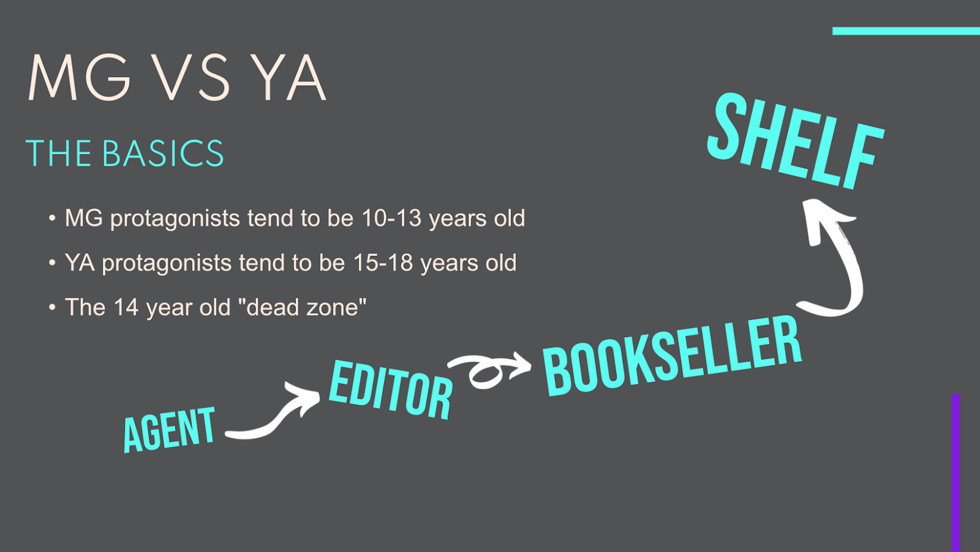
Middle Grade protagonists do tend to be between 10 and 13 years old and the main characters of Young Adult novels are between 15 and 18 years old. There are always exceptions, but this is the general rule.
The 14-year-old characters inhabit the dead zone. I know authors with shelved manuscripts that received nothing but rejections because their 14-year-old main characters weren't quite tween enough or teen enough — they were just too on the line. In my opinion, that's a good reason to publish more of those stories because that's such a crucial, difficult age, and it's great to have stories like that out in the world.
The Publishing Chain
Agents want editors to buy their books and editors want booksellers to shelve their books and booksellers have to know where to shelve those books.
Here in U.S. bookstores, Middle Grade lives in the children's section of the bookstore — Young Adult has a whole other section that often is nowhere near the children's section. So the distinction is really important to booksellers. And if it's important to booksellers, it's important all the way down the chain: from the editors to the agents and authors.
So the age of the protagonist does often provide the answer as to whether it's Middle Grade or Young Adult, but there are lots of exceptions, like The Curious Incident of the Dog in the Night-Time. It has a 15-year-old protagonist, but it's shelved in the adult section. Liesel is the nine-year-old main character of The Book Thief, but I have found that in the Middle Grade section, the Young Adult section, and the adult section of various bookstores.
The His Dark Materials trilogy revolves around an 11-year-old girl and a 12-year-old boy with a significant amount of page time given to adult characters. And I've seen it shelved as Young Adult and Middle Grade. So you can see there's a little more to it than just the age of your protagonist.
So as my critique partner pointed out that day in the cafe, it isn't about the physical age of your protagonist. It's about their emotional age. A Middle Grade protagonist is discovering how they fit into the world. A Young Adult protagonist is discovering how they can change and affect the world. In that draft of what I thought was my Middle Grade book, my main characters fell into that Young Adult category. I said in the book that they were 12, but emotionally and mentally speaking, they were older than that. And it showed in the decisions and the choices they made throughout the book. And that was what my critique partner had pointed out to me.
“You can never go home again”
Another way to think about this is how your protagonist relates to the idea of home and what home means to them.
In all of my kid-lit writing courses, I use Cheryl Klein's book, The Magic Words. I highly recommend it if you're looking for another writing craft book and you write Middle Grade or Young Adult. It is a brilliant masterclass. In that book, she has two things to say about Middle Grade protagonists and Young Adult protagonists:
Middle Grade protagonists are acquiring some independence, certainly, but they still need the anchor that “home” and all it represents provides. When they participate in a grand adventure, it usually ends with the promise of a return home to a safe space, the status quo.
If their family or home situation is a bad one, they’ll want to find a new home, as they’re looking for security, not seeking to strike out on their own. In general, if a novel focuses strongly on its protagonist’s relationship to his family, school, or animals, or if the protagonist is an animal, then my first instinct will be that it belongs in middle-grade.
And her definition for YA:
Young Adult protagonists are interested in the world beyond home: friends, romance and sex, independence, travel, the future. Most times the protagonist’s driving ambition or desire will lie in something that will help them establish an independent identity from their home, and the action will take place outside the domestic sphere.
If family or home do come into the story, it’s usually either as an obstacle (parents or circumstances that keep the protagonist from achieving her dreams), or, interestingly, as stakes, where she has to fight to protect her home or family from threats in the wider world.
So think about your protagonist’s relationship with home to help determine her emotional age.
Two similar books with different outcomes

I have two novels that I love to use in my courses: Hour of the Bees by Lindsay Eagar and The Astonishing Color of After by Emily X.R. Pan. If you have not read either of these books, I highly recommend it because they're just fantastic. They're beautiful, beautiful stories, but they also work well to compare and contrast Middle Grade and Young Adult.
- They're both written in first person present.
- They're both set in the contemporary world, but with a touch of magical realism.
- They both explore themes of grief and loss. What grief and loss do to a family unit and how it might fracture that family unit.
Part of the reason I love comparing them is that they share so many things in common. But there are a lot of differences as well.
In The Astonishing Color of After, which is a Young Adult novel, Leigh, the main character, believes that the spirit of her recently deceased mother — who committed suicide — is now a bird that’s following her around. That's the magical realism bent.
In Hour of the Bees, a Middle Grade novel, our protagonist — twelve-year-old Carol — believes her dying grandfather’s prediction that the bees are going to return. They've been vanished for decades, but they're going to return and save his ranch from an ongoing drought. That's the magical realism bent of that book.
So they share a very similar experience here of losing or having recently lost a family member. But the way they handle their experiences throughout the book is a result of their emotional ages. And as a result, their stories end quite differently.
**Spoilers ahead**
Carol learns about the contentious relationship between her father and his father [who would often tell tall tales]. And in the climax, 12-year-old Carol breaks her grandfather out of hospice and drives him back to the ranch and they end up getting caught in a flood.
In the final scenes, she comforts her father as they sit with her grandfather in his final moments. The very last scene of the book is written in the same style as the wild tales her grandfather spun and we, the reader, learn that she and her family are rebuilding his ranch and creating a new home together.
Like Klein says in her book, Middle Grade protagonists will acquire independence. But they still need the anchor that is home and everything that it represents provides. And even when they participate in an adventure, like stealing a car and getting caught in a flood, the story ends with the promise of a return home to a safe space or their status quo.
Now compare that to The Astonishing Color of After:
Lee is dealing with the death of her mother — who she now believes is a bird. Over the story, she finally allows herself to fall in love with her best friend, who she's been keeping at a distance. She explores more about her mother's side of the family and her Taiwanese heritage. Lee gradually returns to her art, which she abandoned when her mother died, and at the end of the book, she wins the art competition she was previously too afraid to enter. Her final scene shows her literally flying on a plane to see her artwork displayed in a Berlin gallery.
So there you go: YA protagonists are interested in the world beyond home, friends, romance, sex, independence, travel, the future. It hits all of those marks.
Both of those books, such similar experiences for these two girls, but you can see how their emotional age drove their stories in very different directions.
You’re a (middle-grade, then young adult) wizard, Harry!
Whenever I teach a course, Harry Potter always comes up when we talk about Middle Grade versus YA, because people want to know which category does it fall into. I’m sure this could be up for debate but this is what I think.
I think that Harry neatly fits into both definitions, depending on what book you're looking at, except for book four.
In the first three books, Harry learns how he fits into the wizarding world and returns home to the Dursleys at the end of each book. So solid Middle Grade.
In the fourth book, at the 14-year-old dead zone category, he finally comes face to face with Voldemort. He witnesses the death of a fellow student and friend. He begins to understand that there's corruption and incompetence with the adults in his lives. And while he does return home to the Dursleys, this is in every other way, a transitional book.
And then book five starts and he is angsty and defiant and we are just solidly in Young Adult territory where he leads a student resistance against the government. The climax of book five doesn't even take place at Hogwarts — like all the other books did before it — but at the ministry of magic. He is learning how he fits into the wizarding world and how he can affect and change it. This holds true throughout books six and seven (especially the last one in which he only returns to Hogwarts for that final confrontation with Voldemort).
So that's my opinion:
- First three, Middle Grade,
- Book Four who knows,
- The last three books are definitely Young Adults.
What are you “allowed” to write about in Middle Grade?
So the content in Middle Grade is much more restrictive across the board if you're comparing it to Young Adult's.
Romance
If you're writing romance, it's going to focus on first love, puppy love, holding hands, maybe first kisses, that butterfly in the belly feeling of having a crush for the first time. If there's any romance in Middle Grade, that tends to be the limit.
Language
Your characters can swear, but the words tend to not be used explicitly with some exceptions. So you might see the act of swearing (“Dad swore loudly as he tried to fix the television”), but you don't actually get the F-bomb.
Violence
Violence is a little bit trickier, and it really depends on the editor, the publisher, and honestly, on how you write it.
An example that I like to use is the Book Scavenger series by Jennifer Chambliss. This is a bestselling mystery series that’s beloved by kids and teachers and librarians. In the prologue of Book One, an older man in a subway station gets shot in the stomach by two guys who run away and leave him to bleed out. That is super violent and a really horrifying scenario. And one might think, can you really do that in Middle Grade?
But part of the reason I think it works in this novel is that, first of all, the descriptions are not bloody or gory at all. Secondly, the two villains Barry and Clyde — the gunmen who shot the older man — reappear throughout the book and have a very comical dynamic. They’re a lot like Harry and Marv from Home Alone. This adds a bit of levity and comforts and reassures younger readers.
If you think about Home Alone, you could easily refilm that as a horror movie, but because of Harry and Marv and how those two villains are portrayed and how the actors handled their characters, it's a safe movie for kids to watch.
Issues
As far as issues go, and I'm talking here about homophobia, racism, all of that stuff. I believe that the decision as to what a child can or cannot handle reading should be left up to each individual child and their parent or guardian. It is not the job of authors, agents, editors, publishers, teachers, librarians, to decide what is or is not "appropriate" for a child to read. That's an individual, independent decision.
One example that has really stuck with me comes from Kate Messner. She is a fantastic and super popular Middle Grade author. A few years ago, she had a novel come out called The Seventh Wish. This was by no means her first novel. She was already well established at this point.
And in this book, the protagonist is middle-grade. The protagonist's older sister struggles with opioid addiction (a very timely thing to write about), and Messner was shocked at the reception when her book came out. She was disinvited from a school visit. Schools returned her books once they learned what it was about. Numerous librarians told her that they would not be shelving copies of her book. She's not the only Middle Grade author that has had such an experience.
But again, I don't think that means these sorts of topics are inappropriate for Middle Grade readers. In fact, I would argue that younger readers deserve access to all kinds of books: escapist stories about summer camp and pimples and friendship, and also tough issue stories that help them better understand and cope with difficult topics. Kids out there who have family members affected by the opioid crisis could read a book like The Seventh Wish and better process their own circumstances and realize they're not alone. And kids who aren't in that situation can read The Seventh Wish and develop empathy for kids who are in that situation.
Michelle’s Soapbox
So here’s my personal opinion. I've taught hundreds of young readers, and I've read their stories, and they think about this stuff. They know about this stuff. And I found that they are remarkably good at self-censoring and knowing when something is too scary or too mature for them. But they are also very curious, and they want to explore these types of issues because they’re part of their lives. They’re part of our lives, and there's just no safer place to explore what scares you than fiction. So that's my opinion about issue stories.
Mistakes MG Authors Make
I wanted to get into a little bit, the biggest mistake I see aspiring Middle Grade authors make. The first one is the biggest.
Reflecting
Many of the adult writers that I've worked with on Middle Grade, they write fictionalized memoirs. I'm talking historical Middle Grade fiction where the author pulls from their experience as a child in the eighties, seventies, and sixties. And that's fine. I want to be clear that that's not the mistake I'm calling out here at all. There's nothing wrong with that.
The mistake is that even though the characters are fictional and the author has taken creative license with the story, and it's not a memoir, they're still reflecting in their prose. The narrator sounds like an adult telling me a tale from their childhood. So there's a lot of, "Little did I know" or "We didn't know back then" or "In those days we..." And while there are novels out there that read like this, they are not Middle Grade. They’re adult novels with teen or tween protagonists: Secret Life of Bees, Curious Incident..., Boy in the Striped Pyjamas, Where the Crawdads Sing — so many others.
And there's a place for that. And it's absolutely fine obviously, to write that type of story but that's not Middle Grade. That would fall into the adult category.
Preaching
The second biggest mistake I see is preaching and teaching a lesson.
You want themes. Every novel should have themes, but you don't want to be wagging your finger at readers. In my opinion, anyway.
It doesn't matter what you're writing — Middle Grade, Young Adult, any genre — it's much better to discover those things [themes] as you write. There's nothing wrong with starting a project thinking I want to explore forgiveness or betrayal or whatever. That's great. But if you set out to teach a lesson, kids are going to know. They read for the same reasons we do. They just want a good story — not a morality lesson.
These next two mistakes fall under the same category of forcing a particular sound and not writing in your own natural voice.
Simplifying
Simplifying your prose and your voice for kids and dumbing it down. When you were a kid, you knew when an adult was talking down to you, and I bet you didn't like it. So don't do it in your stories.
Mimicking
On the other side of things, don't use slang because you think that's how tweens talk. If you don't know how to use it or don't naturally use it in your real life, it's cringy.
It also dates your book. If you want to write a book set explicitly in a specific period and you're using slang to show that it's that year, then that's great. But if you're just writing a contemporary set Middle Grade book, I would avoid slang because it evolves and changes quickly. By the time your book comes out, things are going to be totally different. So just take care with mimicking.
Marketing Strategies for Middle Grade Authors
I wanted to talk about one last thing: Middle Grade authors’ marketing strategies in the super weird 2020, 2021 climate. A huge part of this will be around school visits and library visits, because that's what's been by far the most valuable thing for me.
School and library visits
Publishers don't tend to send most authors on tours. Only the top tier ones get that. So this is the kind of thing you'll have to organize yourself, but the good news is that schools and libraries love having authors come to visit, especially local authors because that just makes it extra special. “This author lives in my area, that's so cool!”

For an author, that one on one connection that you get with the kids is just such a special experience. It increases word of mouth of your book. No, it's not going to result in crazy sales right there and then but it's part of a slow and steady game.
Kids remember meeting you. The next time you have a book come out, they will want to read it no matter what, because they know you and they think that's so cool.
There was a school visit that I did in Brooklyn at the very beginning of this year. This was a seventh grade “gifted and talented” class who were voracious readers. They read my book, Spell and Spindle, a Middle Grade novel that’s a dark creepy fairytale. And they were super into dark books, and they did not hesitate to tell me so. There was one girl in particular who told me that her favorite author was Stephen King. She went on and on about it. She loved the scary; she loved the blood; she loved the gore. She was just really into it. So they were advanced readers.
Earlier that morning, I had gone to Scholastic to meet with my editor, and he gave me galleys of my latest book, The Dog’s Meow. So I brought five galleys to the class and I was going to end my presentation by donating the galleys to the classroom as a surprise. But this book is actually a little bit younger. It's going to be in the fourth- and fifth-grade clubs and fairs catalog. So definitely not for gifted and talented seventh-grade students.
I started thinking, oh gosh, they're going to roll their eyes so hard when they see this ridiculous cover, because it's got a little kitten and these Huskies and it's just a younger, cute animal story. I got nervous about it but I showed them what I had, they went nuts. They were clamoring for copies. We did a draw to have one of them win a signed copy. And then they all signed up to read the next one. And the girl who loved Stephen King came up to me and the teacher afterward and she was like, "I need to be first on the list to read that book."
My point is that if they had seen that book with the kitten in the bookstore, they might not have picked it up. But they want to read it now because they met me and that made it a special experience for them. And that's just the real value of school and library visits.
Virtual Book Club Tour: Example
This is copy-and-paste from an idea that I had last fall.
So I did a school visit tour in Texas last fall, and one thing I learned was that book clubs are really popular at elementary and middle schools. So even before COVID happened, I was planning on doing a virtual book club tour to get preorders for this Scholastic book that I have coming out. And now that book is bumped to December, so I haven't gotten to test this out yet, but I shared it with Scholastic’s marketing team, and they were really enthusiastic.
I just wanted to share it with you guys in case you think it could be helpful for you.
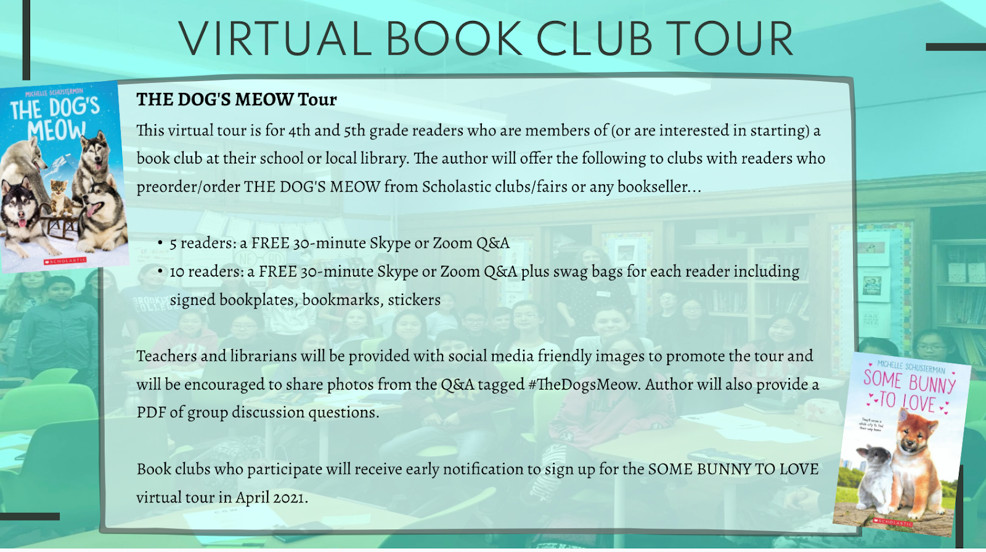
My idea was to send out flyers to librarians saying that for every, say five preorders, I'll do a free virtual zoom or Skype visit for 30 minutes, plus a Q&A. And then for 10 pre-orders, I'll do that plus I'll send the kids swag. Signed bookplates and stickers and things like that. And because I have another book in the same genre coming out in April, I could also offer them a sneak peek and do another visit then.
I also told them I would provide them with social media-friendly images to promote the tour. I was hoping it would do some of the leg work for me in spreading the news about the tour, the hashtag, the title of the book, all that stuff.
I also promised to provide a PDF of group discussion questions for the teachers. Teachers like it when you help them out a little bit there. So like I said, I have not gotten a chance to try this out yet — it’s something I'm going to organize for when the book launches.
Now, more than ever with COVID, this is a really great way to get your books in readers’ hands and get that vital face-to-face time with your readers.
One more thing...
So there's this new thing that popped up just a couple months ago called Talkabook. I don't know if you guys have heard of this but I have signed up for it. I'm part of the network and there are a lot of amazing children's authors there.
What Talkabook does is they schedule paid author visits directly to families through Zoom or Skype. So again, you get that one-on-one connection. You can talk to a child and their parents in their house.
YA marketing plans often rely on online strategies like Bookstagram, BookTube, Twitter, and all that. I'm not saying Middle Grade authors shouldn't do that stuff, but it's not effective in the same way as it is for YA. It doesn't connect you directly to your reader; it connects you to teachers and librarians, and that's super important.
But like I said, that one-on-one connection with kids is just going to change the game with you. So Talkabook, I just signed up. I think they just recently launched and they're still getting things going, but I'm hoping it really takes off. And I hope that that's a really great resource for you guys as well.

